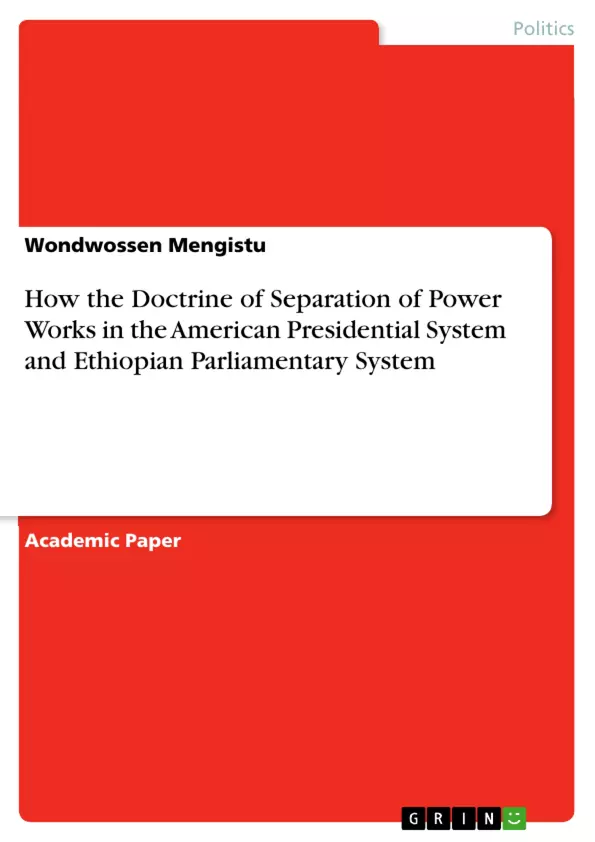The principle of separation of power is one of the oldest constitutional principles in most of the world countries. It refers to the idea that the major institutions of state should be functionally independent and that no individual should have powers that span these offices. The principal institutions are usually taken to be the executive, the legislature and the judiciary. In early accounts, such as Montesquieu’s “The Spirit of the Laws”, the separation of powers is intended to guard against tyranny and preserve liberty. It was held that the major institutions should be divided and dependent upon each other so that one power would not be able to exceed that of the other two. As mentioned earlier most countries of the world both presidential and parliamentary form of government incorporated this doctrine in their constitutions with a certain degree of disparity. American Presidential system with strict separation among the three branches of government, the oldest constitution in the world dating 227 years. On the other hand, all parliamentary systems of government including Ethiopia apply the principle with a certain fusion of power mainly among the executive and legislative organs of government. Cognizant of the above fact as background knowledge, this paper tries to explore American presidential system versus Ethiopian parliamentary system of government based on the original doctrine of montesques separation of power. Thus it is organized in to three parts. The first part deals with the original doctrine of separation of power and its goal. The second part briefly discuss and evaluates the extent to which 1) the executive and legislature; 2) the executive and judiciary; and 3) the judiciary and legislature now overlap and interact in the united state of American presidential and Ethiopian parliamentary system of governments. Last but not the least deals with modifications made by the Americans to the original principle.
Inhaltsverzeichnis (Table of Contents)
- The origin of the doctrine of separation of powers
- The goal of separation of power
- United States Presidential system vs Ethiopia's parliamentary system
- Separation of executive and legislature
- Separation between legislature and judiciary
- The executive and judiciary
- Modifications made by the Americas to the doctrine of separation of power
Zielsetzung und Themenschwerpunkte (Objectives and Key Themes)
This paper examines the application of the separation of powers doctrine in the American presidential system and the Ethiopian parliamentary system. It aims to explore the differences and similarities in the implementation of this principle, considering the original doctrine and subsequent modifications. The paper also assesses the extent to which the separation of powers is adhered to in practice, taking into account the interactions and overlaps between the executive, legislative, and judicial branches.
- The historical origins of the separation of powers doctrine
- The goals and values served by the separation of powers principle
- Comparative analysis of the separation of powers in the American presidential and Ethiopian parliamentary systems
- The role of checks and balances in the separation of powers doctrine
- Modifications to the original doctrine of separation of powers
Zusammenfassung der Kapitel (Chapter Summaries)
- The origin of the doctrine of separation of powers: This chapter traces the historical development of the separation of powers doctrine, beginning with John Locke's contributions and culminating in Montesquieu's formulation. It outlines the key principles of the doctrine, including trias politica, separation of personnel, separation of functions, and checks and balances.
- The goal of separation of power: This chapter explores the fundamental values served by the separation of powers doctrine, specifically focusing on its role in safeguarding liberties, preventing tyranny, and ensuring judicial independence.
- United States Presidential system vs Ethiopia's parliamentary system: This chapter delves into the specific implementation of the separation of powers in both the American presidential and Ethiopian parliamentary systems. It examines the division of powers between the executive, legislative, and judicial branches in each system and highlights areas of overlap and interaction.
Schlüsselwörter (Keywords)
This paper examines the core principles of the separation of powers, focusing on its implementation in the American presidential and Ethiopian parliamentary systems. Key themes include the historical development of the doctrine, its underlying values, the comparative analysis of different governmental structures, the role of checks and balances, and modifications to the original doctrine.
- Quote paper
- Masters Degree (Federalism and Local government studies ) Wondwossen Mengistu (Author), 2017, How the Doctrine of Separation of Power Works in the American Presidential System and Ethiopian Parliamentary System, Munich, GRIN Verlag, https://www.grin.com/document/388337



